Posted by: rring in Gifts

Anti-Tobacco, by Abiel Abbot Livermore; with A Lecture on Tobacco by Rev. Russell Lant Carpenter and On the Use of Tobacco by G. F. Witter, M.D. (Boston: Roberts Brothers, 1883).
This little jewel was given to us by one of our generous Board members, who was the initial donor of our Roberts Brothers collection and has long fed our printed and manuscript holdings related to that publishing firm.
It has a connection to the slave bill of sale mentioned a few posts previously (the author, Abiel Abbot Livermore is mentioned therein), but I also found the following passage about the “gigantic evils” of humanity that were supposedly fading away in 1883 very interesting:
“To attack [the universal use of tobacco] seems as idle as to assault Gibralter with a flight of Indian arrows. But we remember that most of the gigantic evils that have afflicted humanity–such as human sacrifices, idolatry, torture of witnesses and criminals, the persecution of witches, intemperance, polygamy, slavery and the slave trade, or war–could, with equal or greater assurance, claim exemption from from criticism or rebuke on the ground of their antiquity and their universality. Yet all these abominations now lie more or less under the condemnation of the enlightened sentiment of Christendom, and their dark shadows are passing away before the rising light of a nobler and purer civilization.”
I wonder what Mr. Livermore would think of us now? Other than the persecution of witches (any Wiccans in the audience, shout out!), all of these are still current problems.
Comments Off on The anti-tobacco lobby, 1883
We have been thrilled to host the amazing Dr. Scott Gwara, of the University of South Carolina, who has come to the Watkinson Library for several reasons.
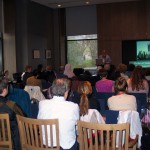 First, he was to give a talk about one of his current projects: a history of medieval manuscripts in North America (he focused his talk last night on those in America’s liberal arts colleges), which he did on the 19th. Dr. Gwara has visited 80 libraries and seen over 3,000 manuscripts so far, and he says he has some 25,000 to go before the project is finished. It was rather breathtaking to hear the stories of the individual collectors who have made it possible for these institutions to own these amazing artifacts of the medieval world.
First, he was to give a talk about one of his current projects: a history of medieval manuscripts in North America (he focused his talk last night on those in America’s liberal arts colleges), which he did on the 19th. Dr. Gwara has visited 80 libraries and seen over 3,000 manuscripts so far, and he says he has some 25,000 to go before the project is finished. It was rather breathtaking to hear the stories of the individual collectors who have made it possible for these institutions to own these amazing artifacts of the medieval world.
The Watkinson’s collection of some two dozen manuscripts were, of course, featured in part of the lecture. Scott had already blogged about them for us on his first visit. Several of these manuscripts came by way of the 19th-century collector Joseph Jesse Cooke (1813-1881), who will be the subject of another post.
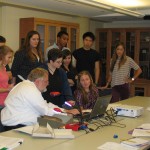 Dr. Gwara is also an extended guest speaker in Jonathan Elukin’s History of the Book class, where he is teaching the students about the structure of Books of Hours and medieval Bibles. Here they are hard at work at their assignments and presentations.
Dr. Gwara is also an extended guest speaker in Jonathan Elukin’s History of the Book class, where he is teaching the students about the structure of Books of Hours and medieval Bibles. Here they are hard at work at their assignments and presentations.
Each student was asked to identify different parts in their books of hours and Bibles, and it was a great moment to see one group exclaim “we GET it!” in surprised delight.

 Scott Gwara graduated summa cum laude from Hamilton College and, as a Marshall Scholar, earned a second BA in Anglo-Saxon, Norse, and Celtic from Cambridge University. He received his PhD from the University of Toronto, where he was a Mellon Fellow. Scott has authored five books and forty articles on Medieval Latin, Old English literature, manuscript transmission, and medieval education. His forthcoming works are on genre in Old English, treasure-giving in Beowulf, and the notorious book destroyer Otto F. Ege. Among other things, he is currently writing a history of medieval manuscripts in North America. For the past 18 years Scott has taught at the University of South Carolina.
Scott Gwara graduated summa cum laude from Hamilton College and, as a Marshall Scholar, earned a second BA in Anglo-Saxon, Norse, and Celtic from Cambridge University. He received his PhD from the University of Toronto, where he was a Mellon Fellow. Scott has authored five books and forty articles on Medieval Latin, Old English literature, manuscript transmission, and medieval education. His forthcoming works are on genre in Old English, treasure-giving in Beowulf, and the notorious book destroyer Otto F. Ege. Among other things, he is currently writing a history of medieval manuscripts in North America. For the past 18 years Scott has taught at the University of South Carolina.
Comments Off on Dr. Scott Gwara’s visit to Trinity
[Posted by Sally Dickinson, Associate Curator]
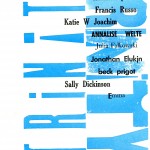
I was invited to go on a field trip to New York with the Book History class at Trinity. It was a beautiful fall day and proved to be inspirational in more ways than just a walk down Madison Avenue. Our first stop was The Center for Book Arts. It was a great opportunity for me to make contact with an organization that fosters creative work in making and reinterpreting the book. I chatted with book artist Roni Gross as the class arrived and quickly looked at a collection of broadsides on poetry that was produced at the Center. From my perspective as a curator and book arts devotee, it was extremely helpful to see historical presses and to participate in a printing exercise that Roni deftly guided us through. She gave an overview of the history of printing before we dove into composing our names from monotypes for a group broadside. We all got to pull a couple of prints from 2 working vandercooks, a type of press favored by artistic printers today.
Next stop was one of my favorite places in the city—The Morgan Library at the corner of 36th and Madison. When I want to see how things should be done in a rare book library, I often look to the Morgan as an example. “Money is no object” seems to be their motto, which works for uncompromising displays of cultural artifacts and a world-renowned collection of rare books and manuscripts. Several years ago the brownstone mansion had been renovated and expanded with a stunning modern addition. It’s important to have low light levels on paper artifacts and to support the bindings of fragile books. The architecture supported these requirements in an elegant way. The modern, plexiglass display cases at the Morgan had hidden lighting inside a metal frame that made the books & manuscripts a focal point. I was an architect in my former life and sometimes I find myself looking at the design of the cases more than the treasures inside! The highlight of the visit was a seminar with curator Roger Wieck, who showed the class some of the remarkable medieval Books of Hours from the library’s collection. I was also impressed by our students’ ability to interpret, under Wieck’s guidance, the text and images of the 15th century manuscripts.
Comments Off on Road Trip of the Book!
 Just acquired, a fascinating and perhaps a hopeful document related to slavery. This is a bill of sale for a slave, but it is possibly a case of a husband buying his wife out of slavery.
Just acquired, a fascinating and perhaps a hopeful document related to slavery. This is a bill of sale for a slave, but it is possibly a case of a husband buying his wife out of slavery.
The first part reads, “Know All Men by these presents that I Catherine M. Folwell of Nashville, State of Tennessee, Widow, for and in consideration of the sum of Six Hundred Dollars to me in hand paid by Dow Johnson, now of Boston in the State of Massachusetts, the receipt whereof is hereby acknowledged, do hereby bargain and sell unto the said Dow Johnson, his executions & assigns forever a certain negro slave called Jane Johnson aged about 25 five years. And I, the said Mrs. Folwell do warrant the said negro to be a slave for life [the words: ‘to be sound, healthy, &’ have been crossed out] sensible, and warrant the title to said Dow Johnson, his heirs & assigns forever against all persons whatsoever. In witness whereof I do herein set my hand and seal this 23rd day of December A.D. 1852. Catherine M. Folwell. Witness: Ira Conwell and Jesse W. Page.”
It’s quite possible that this bill of sale was written by one of the witnesses, perhaps Conwell. On the second page is a lengthy endorsement by the Clerk of the County Court F.R. Chatham who attested to the validity of the bill of sale on January 31, 1853. Below this is the written endorsement of Phinehas Garrett County Registrar recording the bill of sale into the records of the County. One the third page is written, “This Bill of Sale is according to the Laws of Tennessee, and this negro woman Jane is to be delivered to Revd. Abiel Abbott [sic.] Livermore at Cincinnati, Ohio to be sent on to Boston, Massachusetts. Francis B. Fogg.”
Reading between the lines, it is possible that Dow Johnson remained in Boston and was most likely a freed slave (whether by purchase or escape is not known). However, he was prudent enough not to go to Tennessee on his own. Abiel Abbot Livermore was a Harvard-educated, New Hampshire native who became a Unitarian minister in 1836. He was editor of the Christian Inquirer, NY. He was called to the parish in Cincinnati in 1850 and no doubt had abolitionist leanings. Thus he helped arrange the purchase of and passage for Jane Johnson who was probably the wife of Dow Johnson. More research must be done on this document to prove or disprove these possibilities.
Comments Off on Free African-American buys his wife out of slavery?
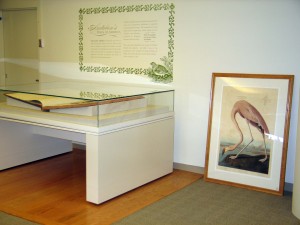 One of the first things I learned upon starting at the Watkinson was that our copy of the Birds of America, which was given to Trinity by one of its early graduates in 1900 (Dr. Gurdon Russell, Class of 1834), was incomplete. Unfortunately, well before the current security measures were put in place, a professional thief had stolen two plates from the book in 1977. One plate (no. 430, the Slender-billed Guillemot) was recovered from a Boston bookseller within a year of the theft—the man also stole from the Connecticut State Library, the Boston Public Library, the Peabody Institute, and the New Bedford Public Library in Massachusetts. The other plate (431, the American Flamingo), was never recovered. Fortunately, we were able to secure a copy of this plate (from another set, owned by a paper company in Alabama) at auction on September 28, so after 35 years, our set is complete again.
One of the first things I learned upon starting at the Watkinson was that our copy of the Birds of America, which was given to Trinity by one of its early graduates in 1900 (Dr. Gurdon Russell, Class of 1834), was incomplete. Unfortunately, well before the current security measures were put in place, a professional thief had stolen two plates from the book in 1977. One plate (no. 430, the Slender-billed Guillemot) was recovered from a Boston bookseller within a year of the theft—the man also stole from the Connecticut State Library, the Boston Public Library, the Peabody Institute, and the New Bedford Public Library in Massachusetts. The other plate (431, the American Flamingo), was never recovered. Fortunately, we were able to secure a copy of this plate (from another set, owned by a paper company in Alabama) at auction on September 28, so after 35 years, our set is complete again.
The fact remains, however, that somewhere out there, on someone’s wall (hopefully unbeknownst to them), is our copy of the Flamingo. Maybe someday we’ll find our wayward bird, but in the meantime, we will cherish our adopted one.
Tags: Exhibitions, natural history, New Acquisition, ornithology
Comments Off on Flamingo comes home!
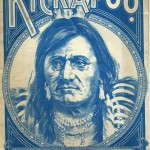 Recently acquired is a piece of ephemeral printing often associated with the traveling medicine shows. The Kickapoo Indian Medicine Company (headquartered in New Haven, Connecticut) published a variety of booklets and other advertisements to promote their products.
Recently acquired is a piece of ephemeral printing often associated with the traveling medicine shows. The Kickapoo Indian Medicine Company (headquartered in New Haven, Connecticut) published a variety of booklets and other advertisements to promote their products.
A great site which outlines the history of the company is here.
And here are some of the advertisements inside:

Tags: New Acquisition
Comments Off on The Kickapoo Doctor
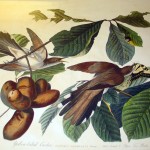 Actually, it’s the Yellow-billed Cuckoo–but in any case, the Audubon is now “in situ” and open to Volume I Plate II — ready for viewing! We will turn the page each Monday (or Tuesday, if Monday is a holiday) for the next 8.5 years and enjoy 433 new birds (Plate I, the turkey, was on display all summer, and so has done its duty; in fact, given the approach of Thanksgiving, we think it wants to keep a low profile).
Actually, it’s the Yellow-billed Cuckoo–but in any case, the Audubon is now “in situ” and open to Volume I Plate II — ready for viewing! We will turn the page each Monday (or Tuesday, if Monday is a holiday) for the next 8.5 years and enjoy 433 new birds (Plate I, the turkey, was on display all summer, and so has done its duty; in fact, given the approach of Thanksgiving, we think it wants to keep a low profile).
This plate (along with the other first five) was engraved by William Lizars in January 1827.
The choice of the first five plates was intentional, and the sequence was planned by Audubon during his tour of the Great Lakes in 1824. They included images of one large (turkey), one medium (Canada warbler) and three smaller species (yellow-billed cuckoos, purple finches, and prothonotary warblers).
Fifty copies were “struck off” for coloring, and Audubon was able to present the first set of five plates to the Royal Society of Edinburgh on February 5, 1827, with the venerable Sir Walter Scott in attendance. Audubon was scrambling to gather subscriptions to pay for the work.
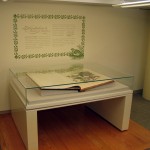 This exhibition is now open, but a more formal opening will be held on Thursday November 3rd. Prof. Christoph Irmscher from Indiana University (his faculty profile is here) will deliver a lecture entitled “How To Read Audubon.” Dr. Irmscher edited the Library of America edition of Audubon’s works, and writes on nineteenth-century American and Canadian literature, early American nature writing, and ecocriticism.From 4:00 – 5:00pm we will have all four volumes on display in the Reading Room, with Dr. Irmscher and myself on hand to answer questions. At 5:00pm professor Irmscher will deliver his talk in the Joslin Family 1823 Room, and we will hold a reception.
This exhibition is now open, but a more formal opening will be held on Thursday November 3rd. Prof. Christoph Irmscher from Indiana University (his faculty profile is here) will deliver a lecture entitled “How To Read Audubon.” Dr. Irmscher edited the Library of America edition of Audubon’s works, and writes on nineteenth-century American and Canadian literature, early American nature writing, and ecocriticism.From 4:00 – 5:00pm we will have all four volumes on display in the Reading Room, with Dr. Irmscher and myself on hand to answer questions. At 5:00pm professor Irmscher will deliver his talk in the Joslin Family 1823 Room, and we will hold a reception.
Tags: Exhibitions, ornithology
Comments Off on The Eagle Has Landed
 First, he was to give a talk about one of his current projects: a history of medieval manuscripts in North America (he focused his talk last night on those in America’s liberal arts colleges), which he did on the 19th. Dr. Gwara has visited 80 libraries and seen over 3,000 manuscripts so far, and he says he has some 25,000 to go before the project is finished. It was rather breathtaking to hear the stories of the individual collectors who have made it possible for these institutions to own these amazing artifacts of the medieval world.
First, he was to give a talk about one of his current projects: a history of medieval manuscripts in North America (he focused his talk last night on those in America’s liberal arts colleges), which he did on the 19th. Dr. Gwara has visited 80 libraries and seen over 3,000 manuscripts so far, and he says he has some 25,000 to go before the project is finished. It was rather breathtaking to hear the stories of the individual collectors who have made it possible for these institutions to own these amazing artifacts of the medieval world. Dr. Gwara is also an extended guest speaker in Jonathan Elukin’s History of the Book class, where he is teaching the students about the structure of Books of Hours and medieval Bibles. Here they are hard at work at their assignments and presentations.
Dr. Gwara is also an extended guest speaker in Jonathan Elukin’s History of the Book class, where he is teaching the students about the structure of Books of Hours and medieval Bibles. Here they are hard at work at their assignments and presentations. Scott Gwara graduated summa cum laude from Hamilton College and, as a Marshall Scholar, earned a second BA in Anglo-Saxon, Norse, and Celtic from Cambridge University. He received his PhD from the University of Toronto, where he was a Mellon Fellow. Scott has authored five books and forty articles on Medieval Latin, Old English literature, manuscript transmission, and medieval education. His forthcoming works are on genre in Old English, treasure-giving in Beowulf, and the notorious book destroyer Otto F. Ege. Among other things, he is currently writing a history of medieval manuscripts in North America. For the past 18 years Scott has taught at the University of South Carolina.
Scott Gwara graduated summa cum laude from Hamilton College and, as a Marshall Scholar, earned a second BA in Anglo-Saxon, Norse, and Celtic from Cambridge University. He received his PhD from the University of Toronto, where he was a Mellon Fellow. Scott has authored five books and forty articles on Medieval Latin, Old English literature, manuscript transmission, and medieval education. His forthcoming works are on genre in Old English, treasure-giving in Beowulf, and the notorious book destroyer Otto F. Ege. Among other things, he is currently writing a history of medieval manuscripts in North America. For the past 18 years Scott has taught at the University of South Carolina.







